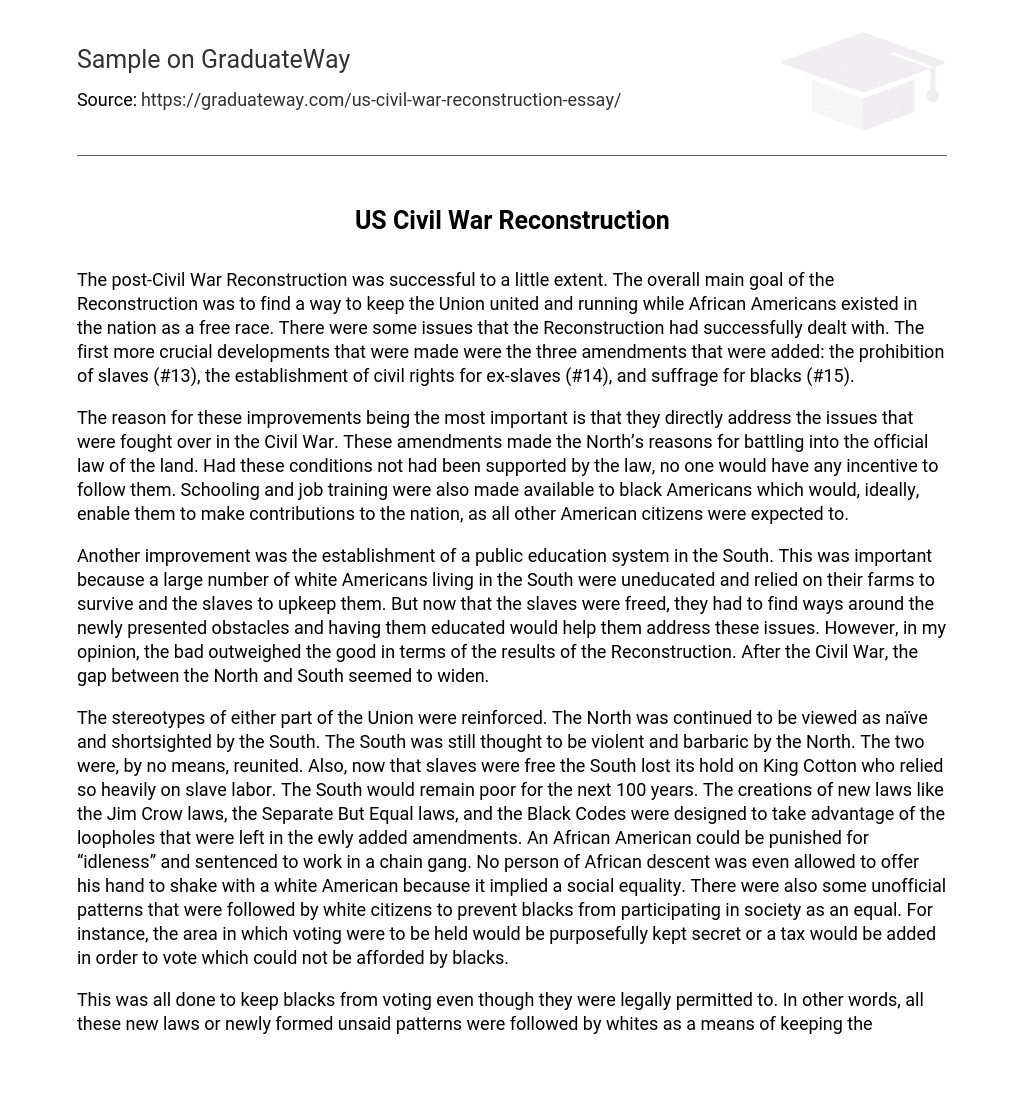The post-Civil War Reconstruction was successful to a little extent. The overall main goal of the Reconstruction was to find a way to keep the Union united and running while African Americans existed in the nation as a free race. There were some issues that the Reconstruction had successfully dealt with. The first more crucial developments that were made were the three amendments that were added: the prohibition of slaves (#13), the establishment of civil rights for ex-slaves (#14), and suffrage for blacks (#15).
The reason for these improvements being the most important is that they directly address the issues that were fought over in the Civil War. These amendments made the North’s reasons for battling into the official law of the land. Had these conditions not had been supported by the law, no one would have any incentive to follow them. Schooling and job training were also made available to black Americans which would, ideally, enable them to make contributions to the nation, as all other American citizens were expected to.
Another improvement was the establishment of a public education system in the South. This was important because a large number of white Americans living in the South were uneducated and relied on their farms to survive and the slaves to upkeep them. But now that the slaves were freed, they had to find ways around the newly presented obstacles and having them educated would help them address these issues. However, in my opinion, the bad outweighed the good in terms of the results of the Reconstruction. After the Civil War, the gap between the North and South seemed to widen.
The stereotypes of either part of the Union were reinforced. The North was continued to be viewed as naïve and shortsighted by the South. The South was still thought to be violent and barbaric by the North. The two were, by no means, reunited. Also, now that slaves were free the South lost its hold on King Cotton who relied so heavily on slave labor. The South would remain poor for the next 100 years. The creations of new laws like the Jim Crow laws, the Separate But Equal laws, and the Black Codes were designed to take advantage of the loopholes that were left in the ewly added amendments. An African American could be punished for “idleness” and sentenced to work in a chain gang. No person of African descent was even allowed to offer his hand to shake with a white American because it implied a social equality. There were also some unofficial patterns that were followed by white citizens to prevent blacks from participating in society as an equal. For instance, the area in which voting were to be held would be purposefully kept secret or a tax would be added in order to vote which could not be afforded by blacks.
This was all done to keep blacks from voting even though they were legally permitted to. In other words, all these new laws or newly formed unsaid patterns were followed by whites as a means of keeping the blacks as low in society as possible. Even still, some slave owners refused to give up their slaves or would kill any ex-slaves they saw. Sure, legally blacks were accepted as a liberated race but there was still the battle of getting Americas to accept and abide by these new terms.
The Reconstruction was effective to a little extent. The North and South remained as separated as ever. The South was overwhelmed with poverty. The newly added amendments were a major improvement because it officially made blacks freed members of society. However, white Americans found ways around these amendments and cut them off from participating in society. The African American race still remained a slave to the society in America. The bad outweighed the good in the Reconstruction.





